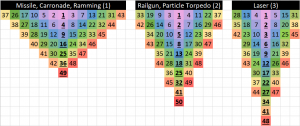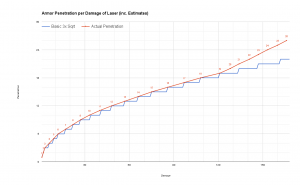Aurora is on version 2.5.0 C#, available at the Aurora Forums.
Contact Erik on the forum for a wiki account.
Armor
Description
Armor is used for the outer hull of all ships. All ships carry at least one layer of armor. PDCs get an additional 5 layers of armor for free.
Usage
Armor is the basic passive defense, represented in Aurora as a grid of armor cells. The height of the grid is determined by the armor rating of the ship, whereas the count of columns is determined by the number of components the armor must cover. Incoming fire destroys cells of armor instead of the internal components of the ship. Every larger ship needs some form of armor to survive. The most important quality for armor to have is thickness, as a ship does not need to be completely stripped of armor for damage to pass through to the internal components underneath.
Armor does not protect against Mesons and High-Powered Microwaves, nor does it help against the effects of Shock Damage.
Larger ships get thicker armor for the same percentage of armor, representing that the surface area grows slower than the internal volume of the ship. The first few levels of armor tech also benefit civilian constructions as it reduces the mass used on their single armor layer, although this gets negligible with better armor tech.
A major limitation of armor is that it may only be repaired in a shipyard or hangar.
Variants
| Type | Conventional | Duranium | High Density Duranium | Composite | Ceramic Composite | Laminate Composite | Compressed Carbon | Biphase Carbide | Crystalline Composite | Superdense | Bonded Superdense | Coherent Superdense | Collapsium |
|---|---|---|---|---|---|---|---|---|---|---|---|---|---|
| Strength per HS | 2 | 5 | 6 | 8 | 10 | 12 | 15 | 18 | 21 | 25 | 30 | 36 | 45 |
| RP cost | 250 | 500 | 2,500 | 5,000 | 10,000 | 20,000 | 40,000 | 80,000 | 150,000 | 300,000 | 600,000 | 1,250,000 | 2,500,000 |
Penetration Mechanics
Armor is penetrated when a column of armor is completely damaged. The way in which this damage is applied varies by the type of weapon causing it. For missiles and carronades, the penetration depth is approximately equal to the square root of the total damage. For Railguns and Particle Beams the penetration is approximately equal to the square root of twice the damage, and for Lasers the penetration is approximately equal to the square root of triple the damage.
Square-by-Square Penetration
For most strikes, the exact pattern of damage on armor may be predicted reliably. The image at right shows the expected pattern of damage for missile and carronade strikes at left, while lasers are shown at right. A hit of a given damage will destroy all squares equal to or lower than its value. For example, a size-nine missile will destroy all squares with a value of nine or less in the template.
The pattern in which damage is applied favors the design of weapons which deliver a damage found in the central column of the template, due to those numbers representing the first penetration into an additional layer of armor. This represents the least damage required to penetrate that particular armor layer and therefore the most efficient warhead or beam strike.
It should be noted that while this is relatively accurate for lower-damage weapons, higher-damage weapons (particularly lasers, as outlined below) can display a high degree of divergence from this relatively orderly progression. This is really only an issue for missiles and lasers, however, as the highest-single shot damage for all other weapons is small relative to the potential damage from missile and laser strikes.
High-Damage Lasers
While the originally-stated penetration equations hold for lesser damage levels, extremely high-powered lasers are prone to penetrating several levels deeper than the square root of triple their damage. Armor penetration for lasers is approximately the root of triple the damage, as noted above, until around 70 damage when the armor penetration starts to become slightly greater than the expected value for that damage.
After around 128 damage, the penetration per additional damage begins to increase rapidly until at 168 damage (the damage of the best non-spinal-mounted laser emplacement) the armor penetration is at 26 layers. This is around 4 levels more than what would be expected at the simpler formula describing the lower-level increase. The graph at right describes the expected versus actual results as damage increases.
| ||||||||||||||||||||||||||||||||

